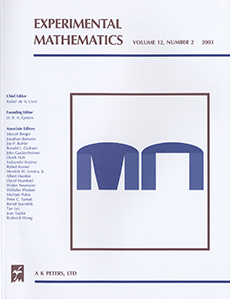Abstract
Given fixed $0 = q_0 < q_1 < q_2 < \cdots < q_k = 1$, a constellation in $[n]$ is a scaled translated realization of the $q_i$ with all elements in $[n]$, i.e.,
$$p, p + q_1d, p + q_2d, \dots , p + q_{k−1}d, p + d.$$
We consider the problem of minimizing the number of monochromatic constellations in a two-coloring of $[n]$. We show how, given a coloring based on a block pattern, to find the number of monochromatic solutions to a lower-order term, and also how experimentally we might find an optimal block pattern. We also show for the case $k = 2$ that there is always a block pattern that beats random coloring.
Citation
Steve Butler. Kevin P. Costello. Ron Graham. "Finding Patterns Avoiding Many Monochromatic Constellations." Experiment. Math. 19 (4) 399 - 411, 2010.
Information




